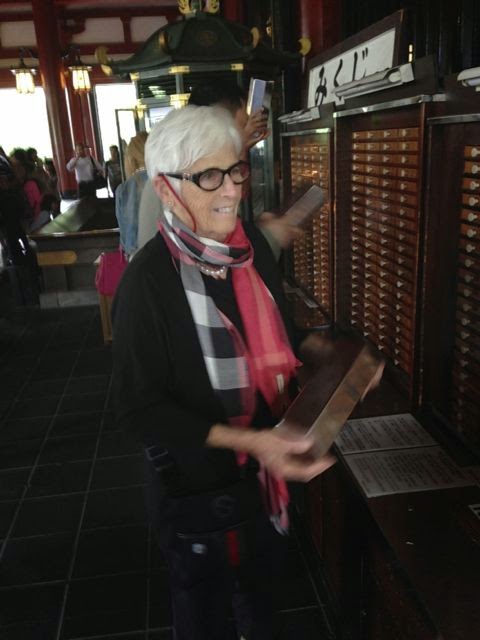 |
| red eel |
My eyes are stuffed.
My feet screaming.
My soul soaring with thanks. It’s been quite a day of new experiences in Tokyo, most of it related to food adventures.
 |
| Out of the way |
 |
| The Fish market in action |
Early rising (who sleeps? body is time-tortured) got us to the Tsukiji Fish Market, known throughout the world as the place where the most expensive and best Tuna is auctioned daily. Yes, once a large tuna – and they can get larger than walruses – brought over a million dollars. (Most everything cost the sky, here in Japan). This riverside market, largest in the world and featuring all sorts of seafood, dates from the Edo period (16th century) but has so outgrown it’s location it must swim to a more ample location in Toyosu in 2016. Although 120 select humans in a lottery are allowed in during the bustling hours, tourist like us are not welcomed until 9 a.m., after the very exclusive auction of fish from seven wholesalers is done (that begins at 5 a.m.). Then we leap into a slippery confusion of styrofoam boxes and blood and ice cubes (like we used in ice boxes when I was a small child) and, worse, turret trucks, which transport the fish and boxes from area to area, and the visitor, taking life in hands, must give way as these fork-lifts driven by single standing young men in a rush. Although over 2000 tons of marine products pass through here per day, we see mostly the remains by 9 a.m. – basketball size heads of tuna severed from their valuable bodies to become sushi delights, red snappers, red breem with bulging eyes, red eels longer than a whip; tiny fish no bigger than a piece of yarn piled in schools; giant crabs with hairy shells, all of it looking so unappetizing, you realize how much we trust sushi chefs to turn them into gustatorial delights.
 |
| red fish |
The rules of the market – no sandals, no high heels, no smoking, no backpacks, no pets or small children, and DO NOT TOUCH anything. But it’s really worth it. I could spend my days wandering through markets taking photos of people and food.
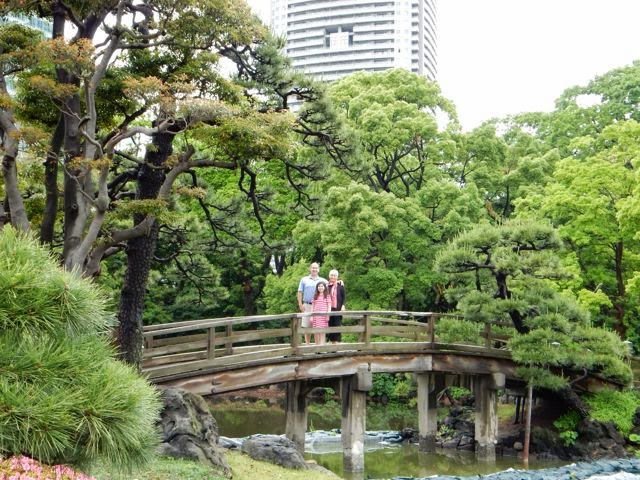 |
| On the Bridge |
There is plenty of market outside the facility as well, where we passed vegetables, herbs, fruit, fish cakes, tamago (egg omelets), and strange comestibles of every shape and odor. As we strolled, samples were offered. One man had a sack of candied walnuts mixed with tiny almost not there fish – all I could see was this eye looking at me – but I braved it and was sorry for a few hours. We also tried some of the many flavors of tamago, some with spinach, others with carrot and peppers, others with sweet things.
After this, we needed to visit the calm and peace of a Japanese garden, where even large pines are pruned and directed so they become, if you could say so, a large bonsai in the ground. (A bonsai is a tree in a container that is being controlled to stay miniature.) In the Hama-rikyu Gardens right in the middle of modern skyscrapers, the family garden of Tokugawa Shogun, there is a seawater pond, tea houses for resting, the spot where shoguns once boarded ships, peony gardens, pruned azalea shrubs covered in controlled pink flowers, wisteria trellis, bridges made of cedar upon which one must have the proverbial photo; a kamoba trench where shoguns with hawks hunted duck; and a 300 year old tree whose heavy branches wander in all directions and had to be propped up over the years.
 |
| 300 year old tree |
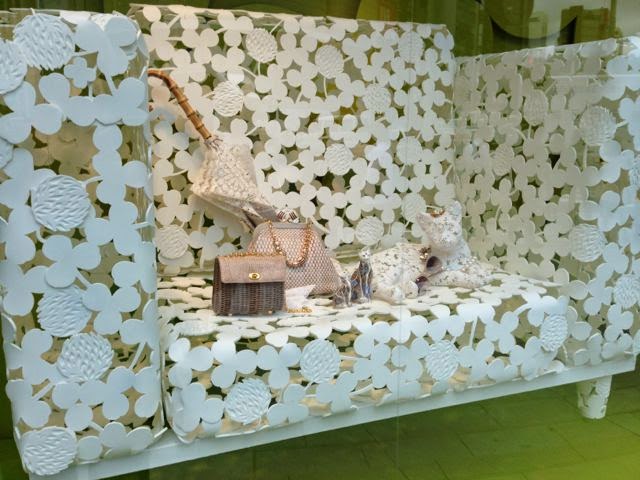 |
| Store display |
From here we launched our energy toward Ginza, the high end shopping area of Tokyo. These stores (the usual high priced fashion houses – Chanel, Vuitton, Prada, Burberry, the Sony showroom – how many phone covers does one need? – and the Apple Store – don’t open until 11 or later. So we walked as the feet began to complain and found open a shop selling French Macarons – Japanese strawberry and green tea were two unusual flavors – and a wild toy shop where Caroline was able to find something she had been looking for a long time.
 |
| tamago for sale |
 |
| Skewer chef |
Lunch was of a different sort. We, hungry, were first to go down into the cellar of Gnvai where three chefs in white were dipping food on sticks into batter and panko crumbs to be fried. We each had a ceramic dish to hold two sauces (one was Worchestershire like, the other soy); another small dish for the chef to put the finished product, and then a ceramic fish with a wide open mouth where one puts the used kebob-like stick. This was not tempura. Each stick carried a different bite size experience of food. The batter was thicker. My favorite was moshi (made from bean paste) stuffed with fish eggs (sounds awful, but it wasn’t.) There were thick asparagus wrapped in prosciutto, sweet potato and onion slices, mushrooms (treasures in Japan), beef, tomatoes stuffed with cheese, and so forth, all tiny samples of goodness. “Hike”, we chanted as we finished each bite. That means we liked it.
The next big thing was to visit Mitsukoshi Department Store Nihonbashi. It is the oldest, largest store in Japan, equal in quality and size to Harrods of London (in fact, in the food section there is a mini sampling of Harrods food products.) But, WOW! This place started as a kimono shop in 1673. The best of the best are housed here, not only in clothes, but in food. What else could one want?
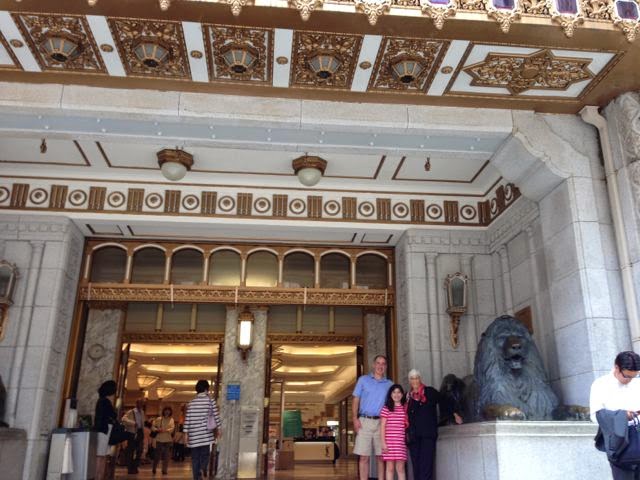 |
| Entering Mitsukoshi |
We started at the 4th floor (there were more, but this was a good place) to see the kimono section – amazing embroidered silk fabrics with price tags beyond belief. Actually, on display was a man’s blue kimono for sale for 30,000 US Dollars. Yep. That’s what I said. This was not unusual. I didn’t even get close to a lady’s kimono, but wandered around admiring the extraordinary needlework. All the sales ladies in this store were amazing, and I did stop by Issey Miyaki’s boutique, an old favorite from my fashion editor days. Miyaki and Yoijo Yamamoto were two of the three original Japanese fashion designers to break into the tight world of New York designers back in the 1970s. (He is a year older than me.) I wanted to see the products of today’s young designers of Japan, but didn’t get much response.
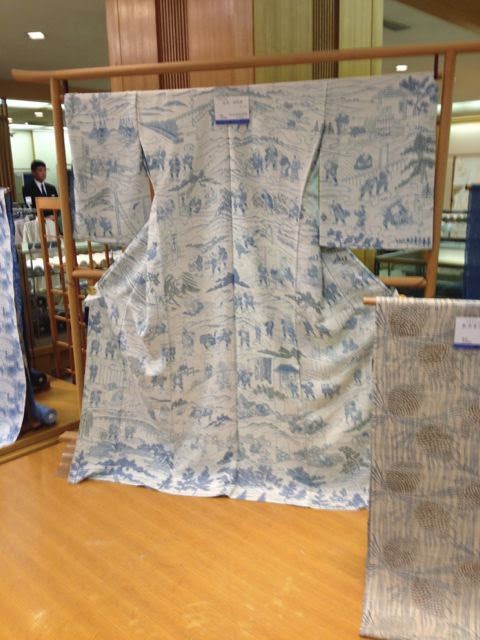 |
| 30,000 man’s kimono |
 |
| Baumkuchen cake |
 |
| Cantelope for $225 |
So we eagerly headed for the basement where food paradise lived. It was the truth. I thought I had seen the best in Bangkok, but here in Mitsukoshi there was so much, so well present, so filled with creativity (samples too) in appearance and taste, I didn’t want to leave. Maybe I should move nearby. I could have sushi, sashimi, lotus salads, amazing veggies, cantaloup valued at 220 dollars for ONE!!! and Japanese cherries (a small box of about 8 cost $65 dollars) which are said to be unbelievable in taste. Forget chocolates (although there were plenty) – I prefer green tea cakes, baumkuchen (a German layered cake on rollers made from 15-20 layers of batter and brushed with a glaze) which is extremely popular in Japan and I had eaten in Uruguay; all sorts of crackers (those made from shrimp I can pass on ), sweets you would never have considered possible; the best fatty tuna in the world, the best fatty beef (Kobe is not the best, there is another brand more highly valued – this meat is so filled with fat it can only be a tender experience); salads from lotus root to roots one has never heard of, and my new fav, jellies of exotic flavors – (sort of jello on steroids but doesn’t have to be kept in the fridge.) Also we sampled mochi – something I could die for – a bean paste dough filled with different flavors. This I associate with Japans culinary art more than anything. We get them frozen at home in markets featuring foreign food, but there is nothing so pleasing as fresh mochi the size of a scoop of ice cream.
 |
| Fruit sandwiches? |
When we finally rolled out of this food paradise, we headed for a much needed visit to a temple to give thanks for our trip so far. The most populated Buddhist temple is Sensoji in Asakusa zone. It was packed with high school kids in uniforms like sailor shirts. Here all the kitch of worship and souvenirs are unleashed to those willing to buy once you pass through the giant red bells painted with black Japanese words. We entered through Thunder gate to walk the shopping street to the actual temple. A five story building on the left (five layers representing earth, fire, water, wind, sky) is said to be where Buddha’s ashes are preserved. No one goes there. Two giant flipflops made from thick rope (I mean giant, like 10 feet tall) were hung on either side of an arched wall to scare off invaders who would fear that behind the entrance someone that big was waiting to jump them.












